
The Origins of Different Calendars
Celestial bodies, seasons formed the framework for ancient calendars
1. Gregorian Calendar: Introduced in 1582 by Pope Gregory XIII, this was designed by Italian doctor, astronomer and philosopher Luigi Lili, and is the most widely accepted civil calendar today. Portugal, Poland and Spain were the first to adopt this in the late 16th century. Also known as the Christian Calendar or the Western Calendar, this solar calendar with months of irregular lengths, is recognised by the UN as the global standard for dates. This calendar is off by about 1 day every 3,236 years.
2. Chinese Calendar: This is a luni-solar calendar based on astronomical observations of the sun’s longitude and the moon’s phases. One of the oldest calendars—its first version was introduced by the Han dynasty in 104 BC—in use among Chinese communities, this has 12 months in an ordinary year, and 13 in a leap year. The Chinese New Year falls on the new moon closest to the beginning of spring (in the Northern Hemisphere), known as Lìchūn.
3. Mayan Calendar: It gets its name from the Mayan civilisation, although the ancient Mayans didn’t invent the calendar—it was used by most cultures in Central America since 2,000 BC. It consists of three different calendars—the Long Count, the Tzolkin (divine calendar) and the Haab (civil calendar)—used simultaneously. Well, if this was precise, the world would have already observed the first anniversary of its destruction!
4. Julian Calendar: Introduced by Roman Emperor Julius Caesar in 45 BC, this was a solar calendar with months of fixed length, and an inter-calary day added every fourth year. The European civilisation considered this a benchmark until 1582 (when the Gregorian Calendar reformed date-keeping). Days were counted from designated division points within every month: Kalends (first day), Ides (13th or 15th of the month), and Nones (eight days before Ides). Remember the Ides of March?
5. Xhosa Calendar: The Xhosas (made famous by Nelson Mandela) are a Bantu ethnic group in the south-eastern regions of South Africa. Their calendar begins in June and ends in May, when Canopus, the brightest star visible in the Southern Hemisphere, heralds the harvest season. Xhosa months are named after stars and seasonal plants: March is EyoKwindla (month of the first fruits), August is EyeThupha (month of the buds).
6. Igbo Calendar: It has its origins in the rituals and symbols of the Igbo tribe of Nigeria, with months dedicated to spirits and deities. It is believed that these spirits had endowed the tribe with the knowledge of time-keeping. The traditional calendar has 13 months in a year, seven weeks in a month, and four days in a week. An extra day is added at the end of the last month.
(This story appears in the 30 November, -0001 issue of Forbes India. To visit our Archives, click here.)





